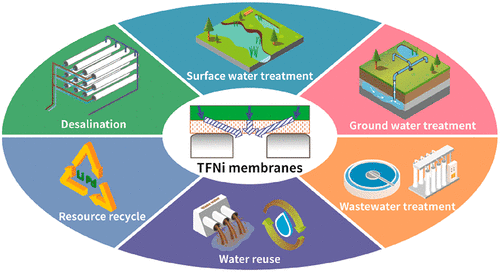当前位置:
X-MOL 学术
›
Environ. Sci. Technol.
›
论文详情
Our official English website, www.x-mol.net, welcomes your feedback! (Note: you will need to create a separate account there.)
A Critical Review on Thin-Film Nanocomposite Membranes with Interlayered Structure: Mechanisms, Recent Developments, and Environmental Applications
Environmental Science & Technology ( IF 11.4 ) Pub Date : 2020-11-19 , DOI: 10.1021/acs.est.0c05377 Zhe Yang 1 , Peng-Fei Sun 1, 2 , Xianhui Li 3 , Bowen Gan 4, 5 , Li Wang 4 , Xiaoxiao Song 5 , Hee-Deung Park 2 , Chuyang Y. Tang 1
Environmental Science & Technology ( IF 11.4 ) Pub Date : 2020-11-19 , DOI: 10.1021/acs.est.0c05377 Zhe Yang 1 , Peng-Fei Sun 1, 2 , Xianhui Li 3 , Bowen Gan 4, 5 , Li Wang 4 , Xiaoxiao Song 5 , Hee-Deung Park 2 , Chuyang Y. Tang 1
Affiliation

|
The separation properties of polyamide reverse osmosis and nanofiltration membranes, widely applied for desalination and water reuse, are constrained by the permeability-selectivity upper bound. Although thin-film nanocomposite (TFN) membranes incorporating nanomaterials exhibit enhanced water permeance, their rejection is only moderately improved or even impaired due to agglomeration of nanomaterials and formation of defects. A novel type of TFN membranes featuring an interlayer of nanomaterials (TFNi) has emerged in recent years. These novel TFNi membranes show extraordinary improvement in water flux (e.g., up to an order of magnitude enhancement) along with better selectivity. Such enhancements can be achieved by a wide selection of nanomaterials, ranging from nanoparticles, one-/two-dimensional materials, to interfacial coatings. The use of nanostructured interlayers not only improves the formation of polyamide rejection layers but also provides an optimized water transport path, which enables TFNi membranes to potentially overcome the longstanding trade-off between membrane permeability and selectivity. Furthermore, TFNi membranes can potentially enhance the removal of heavy metals and micropollutants, which is critical for many environmental applications. This review critically examines the recent developments of TFNi membranes and discusses the underlying mechanisms and design criteria. Their potential environmental applications are also highlighted.
中文翻译:

对具有层间结构的薄膜纳米复合膜的评述:机理,最新进展和环境应用
聚酰胺反渗透膜和纳滤膜的分离特性受到渗透率-选择性上限的限制,该分离特性广泛用于海水淡化和水的再利用。尽管掺入纳米材料的薄膜纳米复合材料(TFN)膜表现出增强的水渗透性,但由于纳米材料的团聚和缺陷的形成,它们的排斥性能仅得到中等程度的改善甚至受损。近年来,出现了一种新型的以纳米材料夹层为特征的TFN膜。这些新颖的TFNi膜在水通量方面显示出非凡的改善(例如,提高了一个数量级),同时具有更好的选择性。可以通过从纳米颗粒,一维/二维材料到界面涂层的多种纳米材料的选择来实现这种增强。纳米结构中间层的使用不仅改善了聚酰胺排斥层的形成,而且提供了优化的水传输路径,这使TFNi膜有可能克服膜渗透性和选择性之间的长期权衡。此外,TFNi膜可以潜在地增强重金属和微量污染物的去除,这对于许多环境应用而言至关重要。这篇评论严格审查了TFNi膜的最新发展,并讨论了潜在的机理和设计标准。还强调了其潜在的环境应用。这使TFNi膜有可能克服膜渗透性和选择性之间的长期权衡。此外,TFNi膜可以潜在地增强重金属和微量污染物的去除,这对于许多环境应用而言至关重要。这篇评论严格审查了TFNi膜的最新发展,并讨论了潜在的机理和设计标准。还强调了其潜在的环境应用。这使TFNi膜有可能克服膜渗透性和选择性之间的长期权衡。此外,TFNi膜可以潜在地增强重金属和微量污染物的去除,这对于许多环境应用而言至关重要。这篇评论严格审查了TFNi膜的最新发展,并讨论了潜在的机理和设计标准。还强调了其潜在的环境应用。
更新日期:2020-12-15
中文翻译:

对具有层间结构的薄膜纳米复合膜的评述:机理,最新进展和环境应用
聚酰胺反渗透膜和纳滤膜的分离特性受到渗透率-选择性上限的限制,该分离特性广泛用于海水淡化和水的再利用。尽管掺入纳米材料的薄膜纳米复合材料(TFN)膜表现出增强的水渗透性,但由于纳米材料的团聚和缺陷的形成,它们的排斥性能仅得到中等程度的改善甚至受损。近年来,出现了一种新型的以纳米材料夹层为特征的TFN膜。这些新颖的TFNi膜在水通量方面显示出非凡的改善(例如,提高了一个数量级),同时具有更好的选择性。可以通过从纳米颗粒,一维/二维材料到界面涂层的多种纳米材料的选择来实现这种增强。纳米结构中间层的使用不仅改善了聚酰胺排斥层的形成,而且提供了优化的水传输路径,这使TFNi膜有可能克服膜渗透性和选择性之间的长期权衡。此外,TFNi膜可以潜在地增强重金属和微量污染物的去除,这对于许多环境应用而言至关重要。这篇评论严格审查了TFNi膜的最新发展,并讨论了潜在的机理和设计标准。还强调了其潜在的环境应用。这使TFNi膜有可能克服膜渗透性和选择性之间的长期权衡。此外,TFNi膜可以潜在地增强重金属和微量污染物的去除,这对于许多环境应用而言至关重要。这篇评论严格审查了TFNi膜的最新发展,并讨论了潜在的机理和设计标准。还强调了其潜在的环境应用。这使TFNi膜有可能克服膜渗透性和选择性之间的长期权衡。此外,TFNi膜可以潜在地增强重金属和微量污染物的去除,这对于许多环境应用而言至关重要。这篇评论严格审查了TFNi膜的最新发展,并讨论了潜在的机理和设计标准。还强调了其潜在的环境应用。



























 京公网安备 11010802027423号
京公网安备 11010802027423号